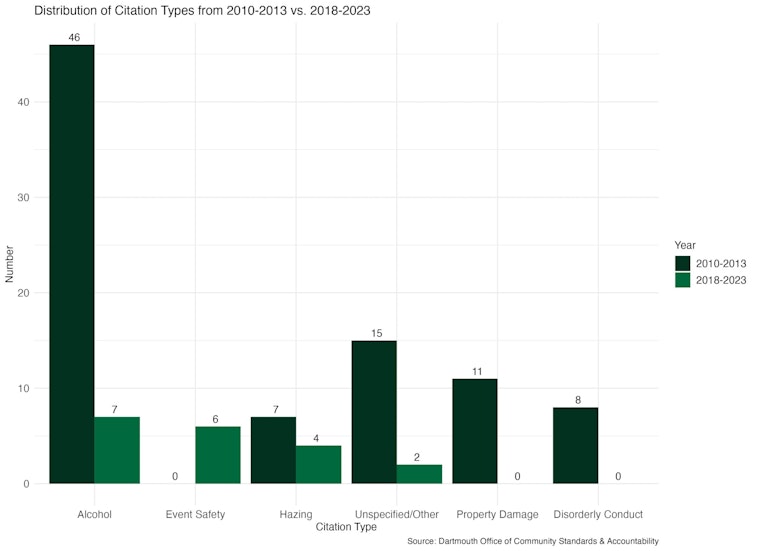In recent years, the Department of Safety and Security seems to have upped its policing at Greek-hosted events, leading to more suspensions, probations and warnings, according to The Dartmouth’s past coverage. While word of mouth is one thing, what does the data say? Are particular offenses more prevalent than other offenses? Do certain types of organizations receive more citations than other organizations? Has the distribution of citations changed over time?
Potential answers to these questions lie within the Community Standards and Accountability Community reports — which contain a plethora of information, ranging from suppositions of hazing to plagiarism. Of particular relevance is the Organizational Adjudication Committee Termly Outcomes report, which — as the name suggests — offers termly recaps of offenses by student organizations, dating back to 2018. While the report does not detail the nature or specifics of the offenses, it lists the name of the organization, type of citation issued (i.e., violation of hazing or alcohol policy) and punishment.
Time series of Citations by Organization

Beginning in winter 2018 until 2023, a look into the number of citations per term shows that, while the number of citations per term has generally been two or less, fall 2019 resulted in citations of eight different organizations. Of the eight organizations, five were fraternities, two were sororities and one was an athletic organization. According to the College, four of these citations were issued after an op-ed briefly published on the Dartmouth Radical’s website prompted the College to conduct an external investigation of student groups, including Greek organizations and athletic teams. Moreover, fraternities clearly outnumber sororities and athletic organizations in the number of citations received. In fact, of the 10 terms during which an organization received a citation, only one term did not include a fraternity during winter 2020.
Suspension or no Suspension?

The graph above examines the punishment types for each citation in the past five years, as well as how many instances resulted in a suspension versus no suspension. For alcohol violations — which include events that violated the College’s alcohol policies — five of the seven resulted in suspensions, while two did not. Event safety — which includes events that violated fire safety policies and the College’s COVID-19 policies — was an even split, with three violations resulting in a suspension and three in no suspension. With the four instances that violated the College’s hazing policies, only one hazing violation resulted in a suspension while three did not. The two unspecified violations of the College’s Hazing and Alcohol Policy — which both came in wake of an investigation to review the activity reported by The Dartmouth Radical — were also split evenly, with one receiving both a suspension and one not. Besides suspension, other punishments resulting from citations include alcohol probation, college probation and mandatory education.
Citations Then and Now

Citing Dartmouth’s report of organization citations from 2010 through 2013 and 2018 to 2023, the distribution of citations has undergone a distinct evolution in the past decade. While over half of all citations from 2010 to 2013 were alcohol related at 53%, only 37% — or seven out of 19 — of citations from the past five years were directly alcohol related, where two were unspecified violations of the College’s Hazing and Alcohol Policy. The College’s Alcohol and Drug Policy — including the hard alcohol ban — was introduced in 2015, which may signal the effectiveness of such policies. From 2018 to 2023, the next largest category of citations was event safety, which made up zero percent of citations from 2010 to 2013. As four out of the six event safety violations from 2018-2023 had to do with large and unregistered gatherings that violated the College’s COVID-19 policy, this is unsurprising.
One of the largest differences in the make-up of citations from the previous decade is in hazing violations. While 21% of all citations in the past five years were in regard to hazing violations, a shockingly low 8% of violations from 2010 to 2013 were hazing related. However, the gap in reporting from 2015 and 2016 — the years, respectively, in which Alpha Delta and Sigma Alpha Epsilon fraternities were derecognized by the College for hazing practices — may have caused this perceived spike in hazing, since these practices likely did not start in 2015 or 2016 but spanned back several years unreported. As a further difference, data from 2013 shows that 21% of citations were either related to property damage or disorderly conduct, while zero such citations have been issued in recent years.
Ultimately, the distribution of College citations to official campus organizations reveals interesting patterns. Although data publicized by the College likely does not encompass each and every violation committed by student organizations, it offers insight into how Dartmouth handles disciplinary matters. As the published data does not yet include citations under President Sian Beilock’s administration, a development of note will be how this current leadership deals with campus organizations — and if their actions are consistent or conflicting with past practices.
Methodology Notes:
The Dartmouth fielded an investigation using administrative data from the Community Standards and Accountability Office reports, focusing specifically on the Organizational Adjudication Committee Termly Outcomes report, beginning fall 2018 to winter 2023, and the 2010-2013 Judicial Affairs Office annual report. The Dartmouth Data Visualization team manually inputted and analyzed the information gathered in these reports.



